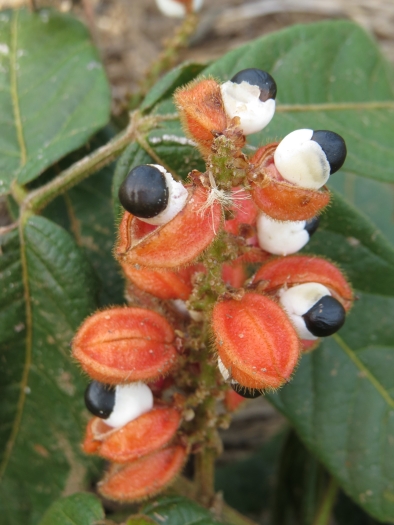Guarana
(Paullinia cupana)
Guarana (Paullinia cupana)
/
/

© Diogo Luiz
CC BY-SA 4.0
Image By:
© Diogo Luiz
Recorded By:
Copyright:
CC BY-SA 4.0
Copyright Notice:
Photo by: © Diogo Luiz | License Type: CC BY-SA 4.0 | License URL: http://creativecommons.org/licenses/by-sa/4.0/ | Uploader: diogoluiz | Publisher: iNaturalist |








Estimated Native Range
Summary
Paullinia cupana, commonly known as guarana, is a climbing plant native to the Amazon rainforest, particularly in Brazil, Venezuela, and Colombia. It thrives in the humid, tropical climates of the Amazon basin, often found in the understory and climbing up trees to reach sunlight. Guarana can grow to significant lengths, with its stems reaching several meters long. It produces large, compound leaves and small clusters of bright red fruit that split open to reveal black seeds partially covered by white arils, resembling an eyeball. The flowers are small, white, and arranged in panicles, blooming throughout the year depending on the region.
Guarana is renowned for its seeds, which contain high levels of caffeine, making them a popular ingredient in energy drinks and dietary supplements. The seeds are ground into a fine powder and used to make herbal tea or added to various products for their stimulant effects. In addition to its use as a stimulant, guarana has cultural significance among indigenous tribes such as the Sateré-Mawé, who use it in traditional rituals. In cultivation, guarana requires a warm, humid environment with indirect light, similar to its native understory habitat. It prefers rich, well-drained soil and regular watering, but it is sensitive to frost and drought. While guarana is not commonly grown in home gardens due to its specific requirements, it is cultivated on plantations in the Amazon region. Potential problems include pests such as scale insects and fungal diseases, which can affect the leaves and stems.CC BY-SA 4.0
Guarana is renowned for its seeds, which contain high levels of caffeine, making them a popular ingredient in energy drinks and dietary supplements. The seeds are ground into a fine powder and used to make herbal tea or added to various products for their stimulant effects. In addition to its use as a stimulant, guarana has cultural significance among indigenous tribes such as the Sateré-Mawé, who use it in traditional rituals. In cultivation, guarana requires a warm, humid environment with indirect light, similar to its native understory habitat. It prefers rich, well-drained soil and regular watering, but it is sensitive to frost and drought. While guarana is not commonly grown in home gardens due to its specific requirements, it is cultivated on plantations in the Amazon region. Potential problems include pests such as scale insects and fungal diseases, which can affect the leaves and stems.CC BY-SA 4.0
Plant Description
- Plant Type: Shrub, Vine
- Height: 10-12 feet
- Width: 4-6 feet
- Growth Rate: Moderate
- Flower Color: White
- Flowering Season: Summer
- Leaf Retention: Evergreen
Growth Requirements
- Sun: Full Sun
- Water: Medium
- Drainage: Medium, Fast
Common Uses
Edible*Disclaimer: Easyscape's listed plant edibility is for informational use. Always verify the safety and proper identification of any plant before consumption., Potted Plant
Natural Habitat
Amazon rainforest, particularly in Brazil, Venezuela, and Colombia
Other Names
Common Names: Guarana, Brazilian cocoa
Scientific Names: , Paullinia cupana, Paullinia brasiliensis, Paullinia brasiliensis, Paullinia cupana f. typica,
GBIF Accepted Name: